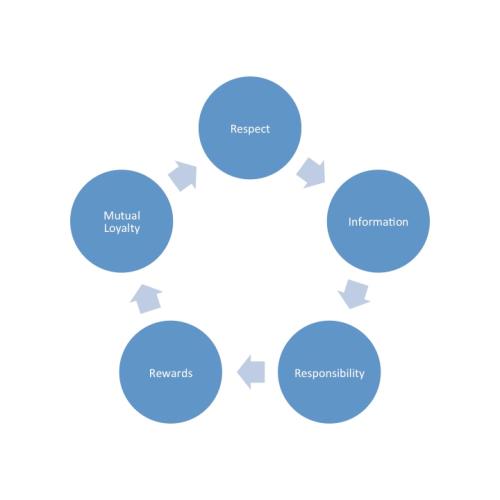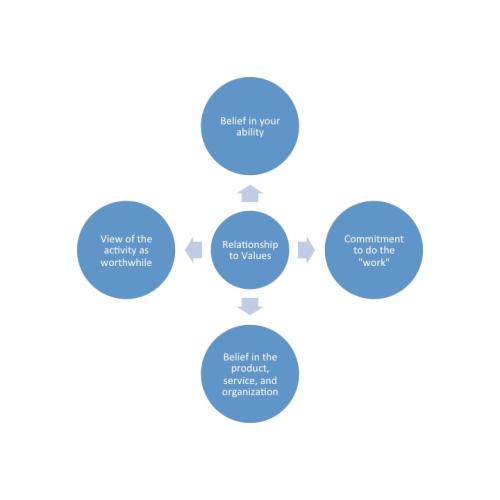By Mark Herbert, Principle Mark F. Herbert & Associates, Inc. and New Paradigms LLC
Creating a corporate culture where great employees want to stay, and quality candidates want to join, is the ideal engagement scenario. Engaged organizations outperform their counterparts on every key performance indictor. In fact, a recent study indicated that organizations with high engagement outperform competitors with low to moderate engagement by an average of 12% per annum on return on assets, and 11% annually on profitability. This scenario does not happen overnight, nor is it bolted on as a department initiative. Engaged organizations develop over time from a coordinated, top down effort to earn a reputation for being among the best places to work. In essence, they brand themselves this way. Much like branding a product that is known for its attributes & customer satisfaction, an Employment Brand represents a company culture that is known for its values, benefits and employee satisfaction.
A client of mine shared a conversation he had with another CEO of a high technology firm who was lamenting that a particular large Midwestern city had a significant shortage of qualified engineering talent. He asked his friend how he had come to that conclusion and his colleague indicated they had been recruiting for talent for almost eight weeks with limited results. My client responded, “There isn’t a shortage of talent, your company has a lousy employment brand. Do you think if Apple or Google were recruiting in this same location they would have any difficulty recruiting the talent they need?”
My client is exactly right. Certain companies, like Amazon, Google, Apple, and Zappo’s, don’t have any issues recruiting the talent they require. They have managed to achieve a certain cachet not only about their products, but about their company; they have a clearly defined employment brand.
Your brand lives where your customers and your employees interact. If your employees are disengaged, turnover increases, interaction does not take place and your ability to attract quality talent into your workforce will be difficult.
You might be asking yourself, why bother to build an employment brand when unemployment is still at historical highs? Here are a few reasons to consider it:
-
The U.S economy is operating at about 30% rate of efficiency because of lack of employee “engagement”
-
55% of Americans are dissatisfied at work and if you look at the under 25 demographic it grows to 64 %.
-
The idea of long tenure only exists with the baby boomers.
-
Three of every five employees are actively monitoring or looking at external job opportunities.
-
Demand for talent- over the next 15 years the demand for “experienced” talent will increase by 25% while the supply will decrease by 15%.
Add to those anecdotal reasons the fact that the U.S Department of Labor estimates that employee turnover costs the U.S economy in excess of $5 trillion dollars annually; I think you have some reasons to consider looking at a different approach.
So how do you create a company culture that is known for its values, benefits and employee satisfaction? I will review a process for that shortly, but first let’s review what so many organizaitons do wrong.
Building a strong employment brand and high employee engagement is not about technology and processes, it is about relationships and trust. It is a deliberate and coordinated practice that is implanted and monitored to achieve specific results.
When I hear employers talk about a deliberate decision not to provide training or coaching to employees because those employees may leave and go to a competitor, or choose to pay lower than market rates because of high employee turnover, I see employers who are making a deliberate choice to create a poor employment brand.
These employers are caught up in a compliance mindset. Employees are assets or human capital. We don’t form relationships with them we have transactions.
So I would ask you a question: “How many organizations that see their relationship with their employees as transactional are able to build and maintain a high valued, sustained relationship with their employees?”
When people stay with an organization or support an objective only because they are afraid of the consequences, you will not get their best effort.
Employees who stay with you because they do not see an alternative will ultimately cost your organization millions of dollars annually through healthcare expenditures, absenteeism and other costs. Or worse, they spread their discontent using pseudonyms on blogs! They can also block other employees from achieving peak performance in the workplace. Negativity spreads and it takes an even greater effort to correct it.
Now let’s look at an alternative approach:
A 4 Four Pronged Approach To Crafting Your Employment Brand
1) THE COMPLIANCE-TO-COMMITMENT® MODEL
This model is build with five distinct elements, each essential, and having strategic and tactical value:

Respect is the cornerstone. Any interpersonal relationship that doesn’t have respect and trust as foundations is doomed to failure. Respect says that I set clear expectations and I expect you to meet them or to seek guidance from me in the event I have not been clear. It is a relationship of partners and people not a transaction.
Information is equally critical. Do I provide you context so that you know where your activities align with organization objectives? Do you have all of the data you need to make informed decisions? Are you comfortable seeking clarification?
Responsibility implies ownership of the tasks as well as investment in the outcome and clear boundaries. You know what your assignment is and how and where to seek clarification. It implies a relationship rather than a transaction.
Rewards include not only hygiene factors like equitable compensation, but other factors like recognition, advancement and the opportunity to grow personally and professionally. Once you get beyond Maslow’s basic needs the desire for intellectual stimulation and socialization are very important to people, especially high achievers.
Mutual Loyalty is a concept I rarely see organizations embracing. We refer to people as human capital and embrace employment at will like a sacred covenant, but then we are outraged when employees seek opportunities where their needs are met more effectively. Loyalty can never be one way.
2) Management Approach
Once you have embraced the concept of Commitment there are some dimensions I would strongly recommend you build into your work environment:
-
Satisfying work content.
-
Meaningful and timely feedback to help Employees improve their skills.
-
Equitable compensation.
-
Maximum delegation.
-
Personal responsibility and “ownership” of their projects and tasks.
-
Clear boundaries and a sense of the big picture.
These dimensions are especially important to the emerging workforce, but I think you will find, as I have, that they have universal applicability across generational, gender, and other boundaries.
3) Hiring Tactics
The next steps in building and sustaining your employment brand are equally critical:
- Hire Hard - Manage Easy
- Hire and manage for Congruency®
- Sustain the right environment
My colleague Joseph Skursky talks extensively about the concept of hiring hard and managing easy. The truth is that most organizations do a poor job of hiring. They hire two dimensional rather than three dimensional people. They don’t examine attributes and values as well as skills and KSA’s (knowledge, skills, and abilities). We need to hire and manage whole people.
Congruency is equally critical and usually overlooked. Dr. Ron Willingham, creator of the Integrity Selling System™, describes congruency like this:

When you look at these factors they are almost intuitive, but bluntly how many organizations take these into account in their hiring and selection process?
Most traditional training activities fail because they don’t look at congruency. If I have a disconnect with any of these key dimensions my block is emotional and visceral rather than intellectual. Training is not going to overcome that.
Congruency does not require you to embrace a particular methodology or approach. Zappo’s, Amazon, Starbucks, Virgin Air, and Google all have very different cultures. The key is that all of them have embedded their culture into their hiring and selection process. They recruit for fit in addition to skills.
Recruit for your values and culture, don’t buy a product off the shelf or adopt someone else’s best practices without examining the fit with your culture.
4) Work Environment
The last part of sustaining your brand is the environment.
An engaged environment includes the following elements:
-
A management team that is competent and skilled in fundamental human relations skills.
-
Satisfying work content.
-
Association with an organization that they respect and that respects Employees.
-
Mutual commitment to Employees and their careers.
-
Meaningful and timely feedback to help Employees improve their skills.
-
Equitable compensation.
I put the competent management team forward as the first dimension because the impact of front line and middle management is huge!
Most employees don’t interact daily or even monthly with senior management or the C suite. Their boss is their world. Your brand lives where your employees interact with your customers….
There are of course other factors like the role of the human resources function, training models, etc. that effect your brand as well, but those are topics for another day and another article….
So where do you go from here? Suggestions:
-
Define your culture. As leaders, creating the culture and ensuring clarity is your key role.
-
Hire hard - manage easy. My colleague Joseph Skursky uses this motto to describe his technique of investing the time to hire the right people, don’t try to “train” them to be right.
-
Hire for congruency. The more alignment you have between the employee’s values and the elements described in Dr. Willingham’s model, the more likely you will have alignment and engagement.
-
Ensure managers have the “tool kit” and that they reinforce your values. Leadership and management are different skills, but there are an essential set of management competencies that all managers must have and be able to demonstrate. I would submit the closer to the frontline, the more critical those skills become.
-
Give employees a chance to commit rather than comply. The numbers work. The model works.
-
Be flexible about process and ruthless about principle. People who cannot, or will not, embrace your values will never be engaged. You owe it to them and yourself to “free up” their future.
I want to leave you with a couple of key thoughts:
-
Nothing that I describe here requires you to be a big company! This 4 Pronged Approach is adaptable to every size organization in every sector.
-
Every organization has an employment brand intentionally or unintentionally. In this age of social media your employment brand is either an asset or a liability. You choose.
Organizations with clearly defined employment brands and high levels of employee engagement always outperform the competition. Why give up a competitive advantage?
I absolutely believe that people join cultures not organizations, and they leave managers not companies. Your product or service brand will never be better than your employment brand.
What do you think? How would your employees describe your employment brand today?
 Written by Mark Herbert, Principle Mark F. Herbert & Associates, Inc. and New Paradigms LLC With over 30 years of managerial, executive, and consulting experience, Mark has authored four books including Managing Whole People-One Man’s Journey; C2C-Compliace to Commitment, A Foundation for Employee Engagement &Building a Culture. He is a consultant, speaker and facilitator on executive development, strategic human resources, employee engagement, and employment branding on a regional, national, and international basis.
Written by Mark Herbert, Principle Mark F. Herbert & Associates, Inc. and New Paradigms LLC With over 30 years of managerial, executive, and consulting experience, Mark has authored four books including Managing Whole People-One Man’s Journey; C2C-Compliace to Commitment, A Foundation for Employee Engagement &Building a Culture. He is a consultant, speaker and facilitator on executive development, strategic human resources, employee engagement, and employment branding on a regional, national, and international basis.
Did you find this story informative? We would like the opportunity to keep you up to date on all of our training articles. Please register for our newsletter so we can do just that.
Here are some additional training articles you may be interested in:
At ManagingAmericans.com we encourage members to go in and out of our communities to learn about different areas of business; how to work together, solve problems and improve skills. Each community details expectations, challenges, success tips, training programs and useful resources. Growing your knowledge base and learning about all areas of business can help you navigate towards success in your career.